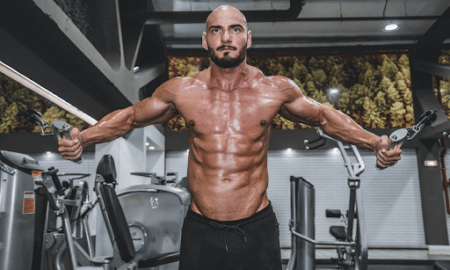Q: My son is 13 years old and wants to try out for his high school wrestling team next year. Any tips on what he should be doing in terms of a workout?
A: Before I answer your question, let’s review some definitions. A concentric contraction is when a muscle contracts and shortens, an eccentric contraction is when a muscle contracts and lengthens, and an isometric contraction is when a muscle contracts and no movement occurs.
In sports they say speed is king. That’s certainly true when you’re going for a single-leg takedown, which is the reason so many strength coaches who work with wrestlers emphasize fast, concentric exercises such as the power clean. When you’re on the mat, however, the muscular effort shifts toward the isometric. So I recommend that young wrestlers emphasize slower movements to more closely approximate the majority of the muscle activity that occurs in their sport.
The following is an upper-body workout I would prescribe for a young wrestler. It contains two pulling exercises and two pressing exercises, performed in superset fashion, for four sets of each exercise.
A-1 Chinups, 4 x 1, tempo 30/0/30/0, rest 90 seconds
A-2 Dips, 4 x 1, tempo 30/0/30/0, rest 90 seconds
B-1 Bent-over EZ-curl-bar rows, 4 x 6,
tempo 5/0/5/0, rest 75 seconds
B-2 Seated dumbbell presses, 4 x 6, tempo 5/0/5/0,
rest 75 seconds
On the chinups you start by pulling yourself to the top position in 30 seconds, and then take another 30 seconds to lower yourself to the bottom. That is one rep and, in this case, one set. On the dips you use the same tempo, but you begin by lowering yourself to the bottom position in 30 seconds and then straightening your arms in 30 seconds.
Give that workout a try. It’s tougher than it looks on paper and is guaranteed to make your son tougher on the mat.
Q: I see that Walmart is now selling vitamin D3. I figure if Walmart is selling it, there must be something behind the hype. I do powerlifting and bodybuilding but have no interest in competing. Would vitamin D3 be a good supplement for me, and if so, how much should I take?
A: The problem with your logic is that Walmart also sells soy-based protein powders! That said, it did right with vitamin D3. Besides fish oils, I would go so far as to say that vitamin D may be the most important supplement for your health, as virtually every disease and adverse medical problem is associated with lower vitamin D levels. Among those problems are the following:
· Autoimmune conditions
· Blood sugar regulation and insulin resistance
· Cancer
· Cold, flu and respiratory-tract infection
· Depression and other neurological concerns
· Fetal brain development and immune function
· Maternal health
· Hypertension and congestive heart failure
· Multiple sclerosis
· Psoriasis
· Rickets, bone density, osteoporosis, osteopenia,
osteomalacia
In addition to what I’ve learned from scientific, peer-reviewed research about the benefits of vitamin D3 supplements, I get nothing but positive feedback from bodybuilders, powerlifters, weightlifters and other athletes about their experience with vitamin D3 in helping build strength and size.
How much vitamin D3 do you need? Probably more than you think and certainly more than the amount recommended by the supplement companies that design their D3 capsules to contain less than 5,000 international units (one company offers capsules of 500 I.U.). I’ve found that if you supplement with 5,000 I.U. of vitamin D3 every day, you should achieve the normal range within about three months. I’ve achieved better results using a much higher dose twice a week, such as 30,000, until reaching optimal D3 levels.
There is, however, an asterisk associated with those numbers.
What you must consider is that before designing a vitamin D3 protocol, I encourage my clients to get their D3 count checked so we can establish a baseline; they get rechecked later to see how the protocol is working. As with any supplement, you should always check with your health-care professional to see if there are any contraindications for taking higher doses.
There is no other substance I know of that has this kind of power behind it. So, yes, when it comes to vitamin D3, Walmart knows best!
Q: How often should I change exercises? I am a 24-year-old male and have been lifting for two years. I can bench-press 305 pounds at 175 pounds bodyweight.
A: In the ’70s a top bodybuilder wrote a training booklet that had a question-and-answer section, and one of the questions was, “When is the best time to train?” The answer: 2:30! Any more questions? Class dismissed.
That example illustrates one of the major problems in strength and bodybuilding training in that those involved in them are often looking for a single, simple answer to their questions. Unfortunately, all the information necessary to determine rate of exercise change cannot be addressed in this column; for that, you must consider such factors as genetics, fiber makeup and nutritional status. Let me give you an example.
A coaching colleague and I conducted an experiment with six different national teams in preparation for the Albertville Winter Olympic Games in 1992. We were testing the validity of a premise: If athletes make great progress changing their workouts every six training sessions, changing at every workout would be even better-—more is better, right? And hey, having a new workout every training day might help with motivation—variety is the spice of life, right? Not quite.
What we found was that only 11 percent of those gifted athletes responded well to changes made at every workout. Again, they were Olympians. If we extended that experiment to the general population, a much lower percentage would benefit from training. Although it’s interesting to examine the training programs of elite athletes, it is unlikely that they would be appropriate for the average trainee.
In the early days of modern bodybuilding, when much attention was focused on the training coming out of Gold’s Gym in Venice, California, many of the best bodybuilders performed an extremely high volume of training. How high? As much as 20 sets per –bodypart! Whether those workouts were actually performed or were simply a media trick to generate interest in the champion bodybuilders of that era, the fact is that few people could make progress on such programs without chemical enhancement.
Further, it’s likely that the top bodybuilders would have made better progress on lower-volume programs. When I hear of the success that some elite bodybuilders have had with low-volume workouts, I attribute much of their progress to the fact that they were previously so overtrained. As I am fond of saying, Fatigue masks fitness!
Another example of how individual response bears on exercise change was an experiment performed by Russian weightlifting coaches who concluded that one of the most important traits of a champion weightlifter was the ability to tolerate a high volume of training. Lifting candidates were given an initial program that involved high-volume methods, such as 15 to 20 sets of snatches in one workout. After the first few weeks more than half the candidates quit. Within a few months, when only a few athletes remained with the program, the prevailing opinion among the coaches was that the remaining athletes were likely to be among the highest achievers in the sport.
The bottom line is that you cannot overlook the unique, innate qualities of the individual when designing resistance-training programs. Some will respond better to frequent changes in exercises—e.g., every one to two weeks—while others will respond better to changes made less frequently, like every five to eight weeks.
Editor’s note: Charles Poliquin is recognized as one of the world’s most suc-cessful strength coaches, having coached Olympic med-alists in 12 different sports, including the U.S. women’s track-and-field team for the 2000 Olympics. He’s spent years researching European journals (he’s fluent in English, French and German) and speaking with other coaches and scientists in his quest to optimize training methods. For more on his books, seminars and methods, visit www.CharlesPoliquin.net. IM




















You must be logged in to post a comment Login